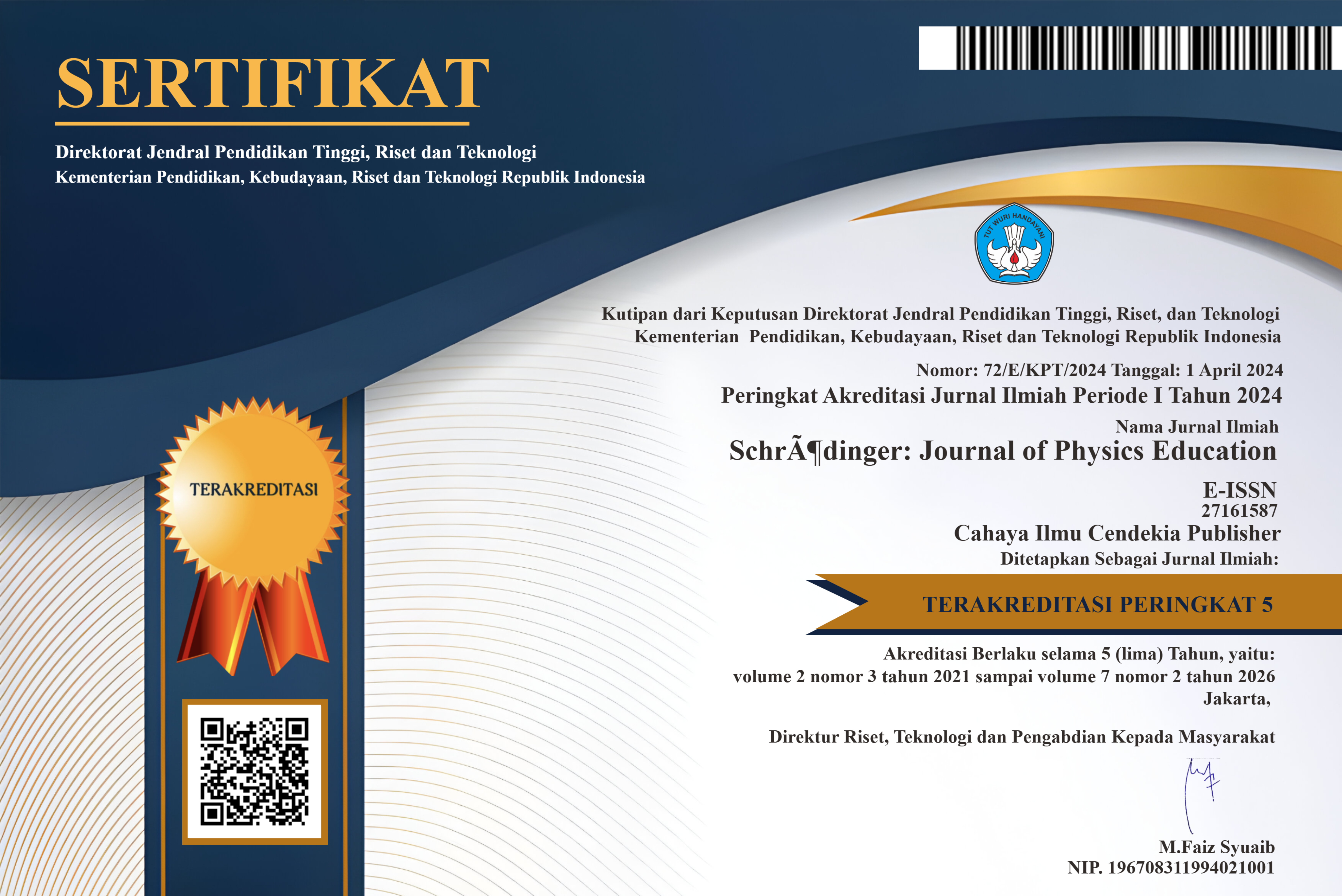Students’ Self-Confident in STEAM
Abstract
Purpose of the study: know the teacher's response about student self-confidence in STEAM.
Methodology: This research uses a micro-ethnographic type case study approach. Case study research is intended to study intensively about STEAM-based physics learning and whether it has a relationship with self-confident.
Main Findings: students will have good self-confidence if a teacher provides good facilities, support, and facilities.
Applications of this study: very useful for teachers in implementing STEAM-based learning to improve self-confidence.
Novelty/Originality of this study: This study describes the STEM-based physics learning experience by growing self-confidence.
References
Sadler, I. “The role of self-confidence in learning to teach in higher education”, Innovations in Education and Teaching International, vol. 50, no. 2, pp. 157-166, 2013. DOI: 10.1080/14703297.2012.760777
Kuswanto. “Where Is The Direction Of Physics Education?”. J. Pijar MIPA, vol. 15, no. 1, pp. 59-64, 2020. DOI: 10.29303/ jpm.v15i1.1226
E. Surya., & F. A. Putri. “Improving Mathematical Problem-Solving Ability and Self-Confidence of High School Students through Contextual Learning Model”. Journal on Mathematics Education, 8(1), 85-94, 2017.
N. G. Lederman., J. S. Lederman., & A. Antink. “Nature Of Science And Scientific Inquiry As Contexts For The Learning Of Science And Achievement Of Scientific Literacy”. International Journal Of Education In Mathematics, Science And Technology, vol. 1, no. 3
J. F. Drazan. "Biomechanists can revolutionize the STEM pipeline by engaging youth athletes in sports-science based STEM outreach". Journal of biomechanics, vol. 99, 2020
S. L. Hanson., and M. Krywult-Albańska. "Gender and access to STEM education and occupations in a cross-national context with a focus on Poland." International Journal of Science Education, 1-24. Alipio, Mark. "Academic Adjustment and Performance among Filipino Freshmen College Students in the Health Sciences: Does Senior High School Strand Matter?." (2020).
Gall. D. M “Education Research an introduction seventh edition”. USA : Pearson Education.Inc (2003).
Cresswel, John W. (2012). Educational Research: Planning, Conducting, And Evaluating Quantitative And Qualitative Research. New York: Pearson
Cohen, L., Manion, L., & Morrison, K. (2007). Research Methods In Education : Routledge.
E. Istiyono., W. S. Brams., R. Setiawan., & I. Megawati., “Developing of Computerized Adaptive Testing to Measure Physics Higher Order Thinking Skills of Senior High School Students and its Feasibility of Use”, European Journal of Educational Research, 9(1), 91–101, 2018.
K. Karyadi., I. L. Sinon., I. Yusuf., & S. W. Widyaningsih., “Correlation analysis between external factors and students’ physics learning achievement”. Scientiae Educatia: Jurnal Pendidikan Sains, 7(1), 42–54, 2018.
M. Snětinová, P. Kácovský., & J. Machalická., “Hands-On Experiments in the Interactive Physics Laboratory: Students’ Intrinsic Motivation and Understanding”, CEPS Journal, Vol 08 (01), 2018, doi: 10.26529/cepsj.319
A. Roger. "Sorption-Enhanced Steam Reforming Of Ethanol For Hydrogen Production." Latin American Applied Research-An international Journal, vol. 50, no. 2, pp. 121-126, 2020
H. Kaya., & U. Boyuk., “Attitudes Towards Physics Lessons and Physical Experiements of the High School Students. European Journal of Physics Education, 2(1), 16–22, 2011. Retrieved from http://search.proquest.com/docview/1553400217?accountid=13360%5Cnhttp://purdue-primo-prod.hosted.exlibrisgroup.com/openurl/PURDUE/purdue_services_page?url_ver=Z39.88-2004&rft_val_fmt=info:ofi/fmt:kev:mtx:journal&genre=article&sid=ProQ:ProQ%3Ahightechjourn
Moussa, Maria, et al. "Toward the cottonization of hemp fibers by steam explosion. Flame-retardant fibers." Industrial Crops and Products (2020): 112242.
Padilla-Rascón, C., et al. "Valorisation of olive stone by-product for sugar production using a sequential acid/steam explosion pretreatment." Industrial Crops and Products 148 (2020): 112279.
C. Haagen-Schützenhöfer, & B. Joham., “Professionalising physics teachers in doing experimental work”, Cent. Educ. Policy Stud. J., vol. 8, no. 1, pp. 9–34, 2018
S. M. Hameed., & E. M. Mohammed., “Enrich the Physics Curriculum Scheduled for Students of Intermediate School E-Learning and Its Effectiveness in Scientific Thinking and Their Attitude Towards the Development of Physics”, Journal of Education and Practice, Vol.7, No.17, 2016
P. Gryczka., E. Klementowicz., C. Sharrock., J.M Montclare., “Interactive Online Physics Labs Increase High School Students’ Interest”, Journal of Technology and Science Education, 6(3): 166-187, 2016, http://dx.doi.org/10.3926/jotse.191
Arista, F. S., & Kuswanto, H. (2018). Virtual Physics Laboratory Application Based on The Android Smartphone to Improve Learning Independence and Conceptual Understanding. International Journal of Instruction, 11(1), 1-16. https://doi.org/10.12973/iji.2018.1111a
Yek, Peter Nai Yuh, et al. "Engineered biochar via microwave CO2 and steam pyrolysis to treat carcinogenic Congo Red Dye." Journal of Hazardous Materials (2020): 122636.
De Pleijt, Alexandra, Alessandro Nuvolari, and Jacob Weisdorf. "Human capital formation during the first industrial revolution: evidence from the use of steam engines." Journal of the European Economic Association 18.2 (2020): 829-889.
Verdín, Dina, Allison Godwin, and Leidy Klotz. "Exploring the Sustainability-Related Career Outcome Expectations of Community College Students Interested in Science and Engineering Careers." Community College Journal of Research and Practice 44.2 (2020): 83-98.
Copyright (c) 2020 Cahaya Ilmu Cendekia Publisher

This work is licensed under a Creative Commons Attribution-NonCommercial 4.0 International License.
Authors who publish with this journal agree to the following terms:
- Authors retain copyright and acknowledge that the Schrödinger: Journal of Physics Education is the first publisher licensed under a Creative Commons Attribution 4.0 International License.
- Authors are able to enter into separate, additional contractual arrangements for the non-exclusive distribution of the journal's published version of the work (e.g., post it to an institutional repository or publish it in a book), with an acknowledgment of its initial publication in this journal.
- Authors are permitted and encouraged to post their work online (e.g., in institutional repositories or on their website) prior to and during the submission process, as it can lead to productive exchanges and earlier and greater citation of published work.






.png)
.png)








.png)
.png)
.png)







